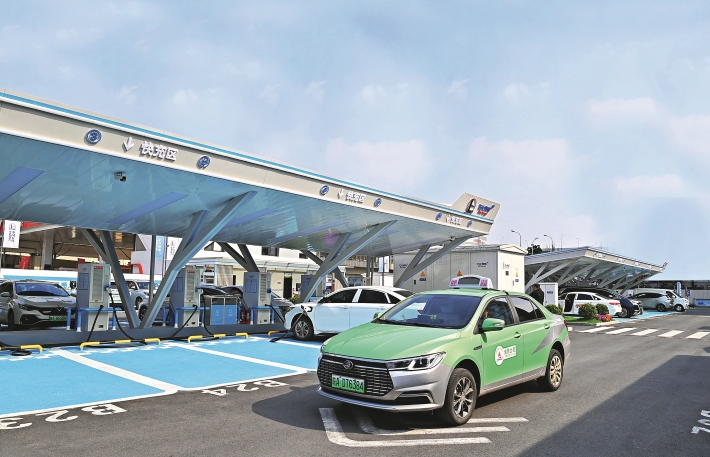|
||||||||||
| Home Nation World Business Opinion Lifestyle ChinAfrica Multimedia Columnists Documents Special Reports |
|
||||||||||
| Home Nation World Business Opinion Lifestyle ChinAfrica Multimedia Columnists Documents Special Reports |
| ChinAfrica |
| Generating Fresh Impetus |
| Factors behind China’s booming NEV industry |
| By Chen Yan | VOL. 16 June 2024 ·2024-06-07 |

An NEV taxi passes a charging station in Hefei, Anhui Province, on 26 March (CNS)
Last year, the export volume of new energy vehicles (NEV), lithium-ion batteries and photovoltaic products, collectively known as the “new three” in China’s foreign trade, reached 1.06 trillion yuan ($146.8 billion), breaking the 1-trillion-yuan ($138.5 billion) mark for the first time. However, as the production and sales of China’s electric vehicles (EVs), NEVs powered solely by electricity, continue to hit new highs, the global auto industry seems to be filled with pessimism about the future of EVs, with Apple cancelling a decade-long car-making plan and Mercedes-Benz adjusting its ambitious electrification strategy. Earlier, General Motors and Ford also suspended their electrification plans. What are the reasons behind this contrast?
The “new three” were not originally created by Chinese companies. Many European, American and Japanese companies started industrialising these sectors before China. However, in industrialised countries, the conflict of interest between electric and fuel vehicles, and between solar power and conventional energy sources, is far greater than in China. The existing industrial structure in these countries has hindered an all-out effort in new energy industries.
The situation in China is quite different. The key technologies of fuel vehicles are not in the hands of Chinese companies, thus there is a weaker foundation for the fuel vehicle sector. Also, it is a necessity for the country to address its dependence on imported oil by developing new energy sources such as solar and wind power based on its natural resources. With millions of EVs sold every year, coupled with the demand for storing energy from solar and wind power, the demand for battery production capacity is naturally high.
Role of oil prices
Affected by the Russia-Ukraine conflict and the Palestine-Israel conflict, the West Texas Intermediate (WTI) crude oil price has increased substantially. It grew from an annual average price of $39.31 per barrel in 2020 to $94.43 in 2022 and stood at $77 in April 2024, with a high possibility of further rise.
According to the National Bureau of Statistics, China imported around 564 million tonnes of crude oil in 2023, a year-on-year increase of 11 percent. The high volume of oil import, coupled with a rapid growth, has made China sensitive to every bit of increase in crude oil prices, putting the country under huge pressure. Therefore, China’s push for NEVs is propelled not only by emission reduction and decarbonisation needs but also a more urgent need than Europe, the US and Japan to replace oil with new energy sources.
The development of battery technology and the subsequent cost drop are other key factors behind the expansion of the EV sector.
Technological innovation is continuing in China’s battery industry, with progress in solid-state battery at the centre of public attention. Such technologies will further solve problems related to EVs such as long charging duration, limited range and fire hazards, and further promote the expansion of the EV industry.
The author is Deputy Editor-in-Chief of People’s China magazine
|
||||||||||
| About Us | Contact Us | Advertise with Us | Subscribe |
| Copyright Beijing Review All rights reserved 京ICP备08005356号-5 京公网安备110102005860号 |